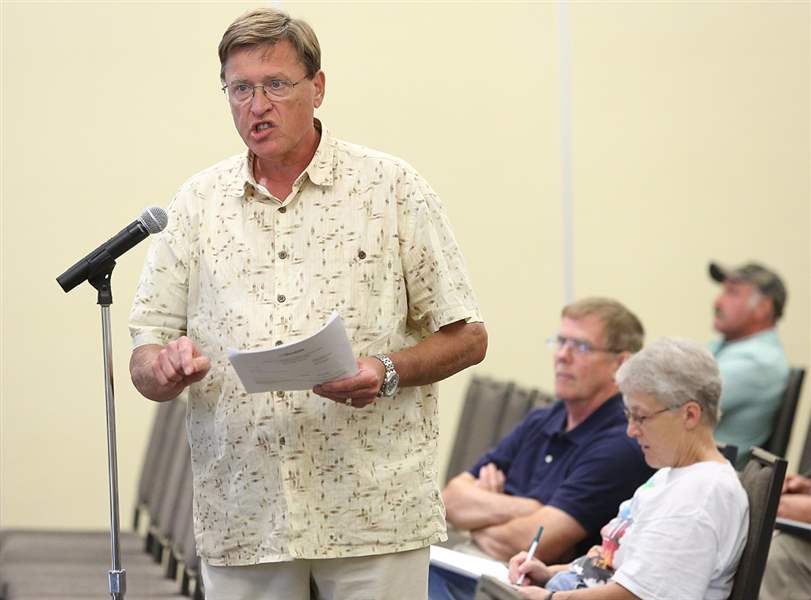
Ohio EPA has public hearing about fate of Ballville Dam
Fremont residents voice concerns over removal
8/22/2014
Randy Rohm speaks during a hearing in Fremont on the removal of the Ballville Dam. Thursday’s meeting was hosted by the Ohio EPA.
THE BLADE/JEREMY WADSWORTH
Buy This Image

Randy Rohm speaks during a hearing in Fremont on the removal of the Ballville Dam. Thursday’s meeting was hosted by the Ohio EPA.
FREMONT — The proposed removal of the century-old Ballville Dam could mean a stronger fish habitat and restored river or spell more toxic trouble for Lake Erie, depending on who decision-makers are listening to.
The Ohio Environmental Protection Agency held a meeting and public hearing Thursday attended by more than 75 people at Terra State Community College in Fremont to hear from those interested in the long-debated fate of the Sandusky River dam.
The state agency is reviewing a water quality certification related to wetlands-filling activities that would occur if the dam is removed.

Allamon
Heather Allamon, environmental specialist from the Northwest District Office Division of Surface Water, tried to keep the meeting narrowly focused on that pending state approval. But some in the crowd wanted a chance to ask questions about myriad other project concerns and benefits.
The U.S. Fish and Wildlife Service and the Ohio Department of Natural Resources both want the dam taken down in incremental stages and an ice-control structure installed. Dam removal is needed because of the structure’s deteriorating condition and to improve fish habitat and water quality, supporters contend.
“Removal of the dam could open up at least 22 miles of Sandusky River’s free-flowing stream and return much needed spawning habitat to an important Lake Erie tributary,” said Fred Snyder, president of the Western Basin Sportfishing Association.
Others, however, worry the removal of the dam will open up the river and Lake Erie to the load of sediment behind the dam. That sediment, they argue, is laced with phosphorus and could contribute to the algal blooms that crippled Toledo’s drinking water system earlier this month.
That silt is “the 800-pound gorilla in the room,” said Randy Rohm of Fremont.
“Moreover, no studies have been done to test the effects of this silt on the river, bay, or lake water ecologies,” he said.
He asked the Ohio EPA to not grant a permit until the sediment impact has been studied.
Ms. Allamon said she is not aware of any study conducted on phosphorus in the Sandusky River. Estimates of the sediment amount range from 840,000 to about 1.3 million cubic yards, though officials believe the amount is closer to the lower number.
The gradual removal of the dam will help prevent problems with the release, she said.
“Some of the sediment is going to stay there, and it’s going to be planted and hopefully turn into some wetlands,” Ms. Allamon said.
She said the Ohio EPA will not be on-site during the dam removal to test water quality.
In addition to the Ohio EPA approval, the U.S. Army Corps of Engineers is reviewing a permit for the dam’s removal. The city of Fremont will make the final decision about the dam’s fate.
Fremont Mayor Jim Ellis said his chief question is whether there will be enough water to survive a severe drought without the dam. The city’s reservoir offers a second water source, and he thinks the city will have what it needs.
Written comments on the Ohio EPA application can be submitted through Aug. 28. Comments can be sent to: Ohio EPA, Division of Surface Water, Permits Processing Unit, P.O. Box 1049, Columbus, OH 43216-1049 or by email to dswcomments@epa.ohio.gov.
Contact Vanessa McCray at: vmccray@theblade.com or 419-724-6065, or on Twitter @vanmccray.